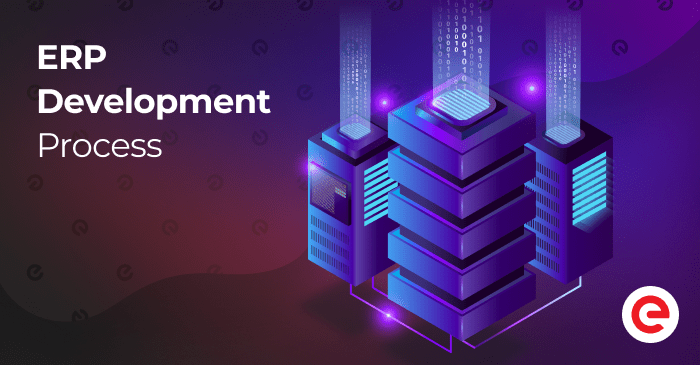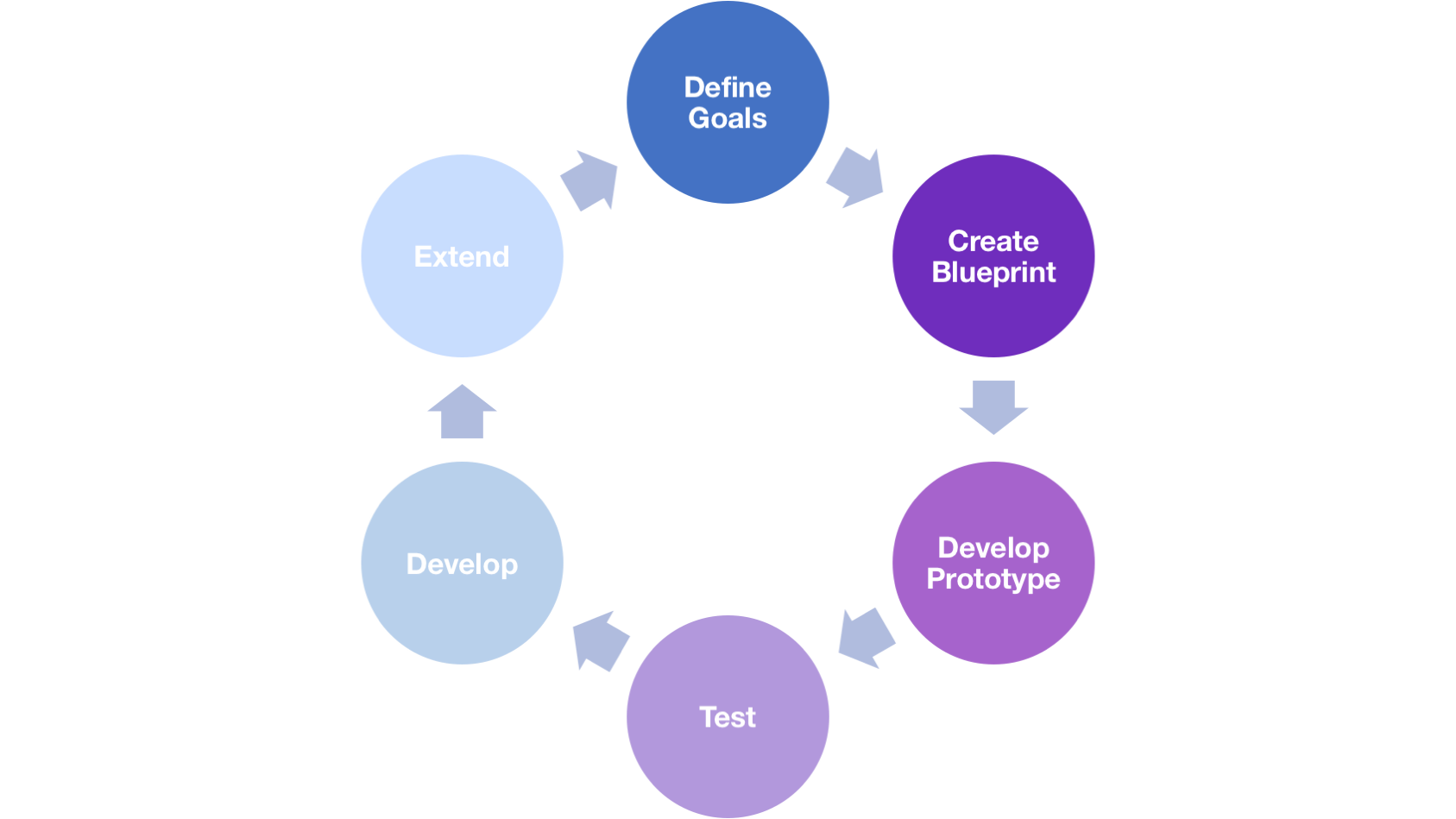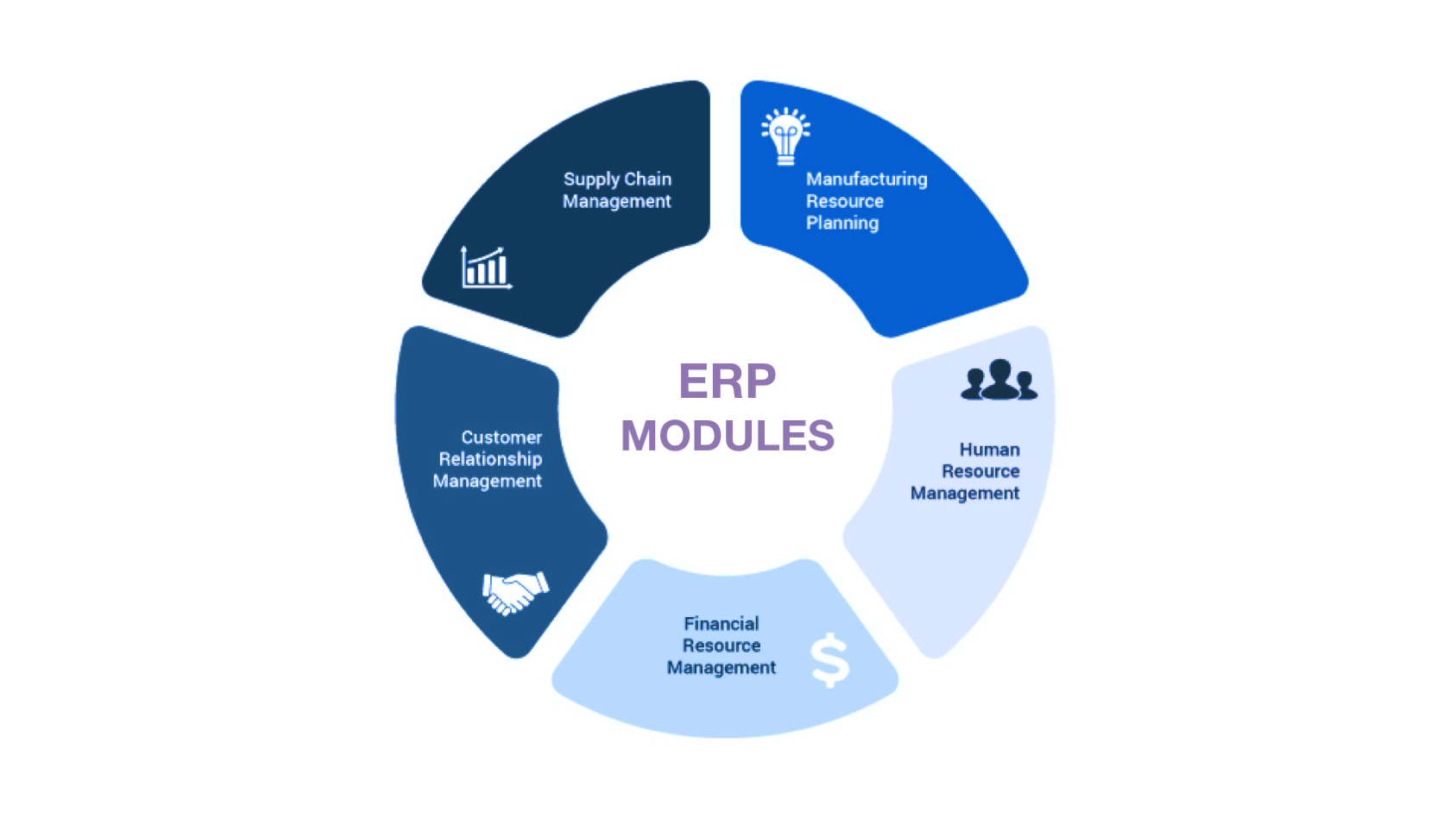
Updated: June 27, 2024
Published: February 23, 2018
How to start ERP development from scratch? We’ve researched the ERP development process, technologies, flow, cost, and timeline. You are also welcome to check our latest blog post about the cost of ERP software with a detailed breakdown of the budget and resources needed for such a project.
Table of the Content
- ERP development process from scratch
- How to approach the ERP development process
- ERP development technologies
- Timeframes and costs for ERP projects
- Conclusion
Whenever an organization or individual approaches a developer with the need for ERP solutions, they are given choices on acquiring the system. There are two prominent ways of implementing this:
Off-the-shelf solutions are the opposite of ERP development from scratch instead of boxed solutions like SAP that can be purchased and ready for use.
Custom ERP system development is a process in which the system is built from the ground and according to the needs of the client and the set requirements.
The first option is pretty obvious, but what if you feel that none of the available ERP solutions would address your requirements, or you want complete ownership of the solution, which will be your mission-critical business tool for the next decade or even longer?
Why choose custom ERP system development? Off-the-shelf software buying and customization will always seem cost-effective and time-saving as a result of fewer up-front fees as well as saving the time taken in the development process. Despite these advantages, quality matters, and building an ERP system from scratch is more likely to meet the systems’ requirements and functionalities.
Is it worth starting custom software development?
We have already dealt with this question in our article dedicated to the advisability of starting ERP development from scratch.
So let’s start with defining the roadmap of how to build your system and address the most frequent questions, such as which technology to choose, how long it will take, and how much it costs.
ERP DEVELOPMENT PROCESS FROM SCRATCH
Enterprise Resource Planning is a critical component of modern businesses that helps organizations to manage their resources effectively. ERP development aims to create a comprehensive system that can integrate and automate different business functions such as accounting, procurement, production, human resources, and customer relationship management.
Analysis and planning
The ERP development process starts with the analysis and planning stage. In this stage, the current business processes are assessed to identify areas for improvement. This involves reviewing the current systems, processes, and data flows to determine the gaps that need to be filled.
The business requirements are then defined, and the project scope is determined. This involves identifying the specific functions and features that the ERP system needs to support. A project plan is created to outline the timeline, budget, and resources required to complete the project. This plan should include clear milestones, deadlines, and responsibilities for each development team member.
Design and architecture
The next stage is design and architecture. In this stage, the system architecture is designed, and software and hardware components are chosen. The architecture should be designed to ensure scalability, reliability, and performance. The choice of software and hardware components will depend on the specific requirements of the ERP solution, including the desired features, performance, and cost.
Detailed design specifications are created to guide the development team. These specifications should include detailed descriptions of the system architecture, data flows, security requirements, user interfaces, and performance criteria. They should also include clear guidelines for coding standards, testing protocols, and documentation requirements.
Development and implementation
The development and implementation stage involves building the ERP system, testing, and debugging, integrating with existing systems, and deploying the system to end-users. The development team works closely with the business stakeholders to ensure that the system meets their needs and expectations.
During the development phase, the code is written, and the system is tested and debugged. This stage should include regular testing and quality assurance procedures to ensure that the system meets the design specifications and performance criteria.
Once the system has been thoroughly tested and debugged, it can be integrated with existing systems and deployed to end users. The deployment process should be carefully planned and executed, including user training and support, to ensure a smooth transition to the new system.
Maintenance and support
Once the ERP system is up and running, it is important to provide ongoing maintenance and support. This includes updates and upgrades, user training and support, monitoring system performance, and troubleshooting and resolving issues as they arise. ERP software should be regularly reviewed and updated to ensure that it continues to meet the changing needs of the business.
The ERP development process from scratch requires a significant investment of time, resources, and expertise. However, the benefits of implementing an ERP system are numerous, including improved efficiency, better decision-making, increased productivity, and enhanced customer satisfaction. The future outlook for ERP development is positive, with continued growth in the market as more organizations recognize the benefits of ERP technology. Let’s continue with more details on it.
HOW TO APPROACH THE CUSTOM ERP DEVELOPMENT PROCESS
Custom systems are more advantageous in delivering the proper needs of business operations, but this is usually in addition to an organized and step-by-step development process. Custom ERP software development is a procedural process that includes the following:

Defining the project’s goals
This is the vision of the ERP development process. The client usually describes it to the developer; they explain what the system should deliver at the end of the development process. Eventually, the client and the IT experts should come to an agreement on what the end product’s functionality and features should be.
Developing a blueprint and wireframing
Like in most operations, a blueprint is the basis of the whole process; therefore, it should be well-detailed. The custom system blueprint contains complete information about the development process, timeframe, and the resources to be used. It is a document created by every individual involved with the target system. This includes the system developers (in-house or outsourced), organization managers, IT leaders, and at times the software’s end user. They are all essential in the creation of the master plan.
Wireframing involves stating the components involved in the custom ERP development process: sales, HR, accounts, procurement, etc. This creates the foundation of which of the business operations and the data to be integrated with the system. The most commonly implemented modules: are Supply Chain Management, Resource Planning, HR Module, Financial Management, and CRM.
When you start to think of how to start ERP development from scratch, it is important to choose your custom solution type. Each choice has some advantages and disadvantages. Let’s make a list of the available options:
- Client/Server ERP will work locally on users’ computers, and the database will be stored on your networking hardware.
- Web-based ERP solution will be running on the external web server and, therefore, can be accessed from any device in the simple web browser.
Technical part
This is the part where developers commence their work. It involves making a decision on the database, backend, frontend, and the whole technical part of how to develop web-based ERP software.
The stack of technologies, such as framework and database, is your custom system’s foundation. Choosing the platforms, framework, and database is a heavily influential blueprinting and wireframing stage. Actually, it is a two-edged sword; for example, you pick the framework depending on what goals you have chosen for the application, what level of security you require, etc. Caused by your choice of framework, you will have it running locally on the user’s machine or accessed with the browser. It is all about compromise and prioritization. If cross-platform compatibility is something that matters to you most of all, then you have to go with Java; if security comes first – then you are most likely to choose .NET as your primary framework.
Where the system is to be hosted. A customized system can be hosted on your local servers or on the cloud. The decision on where to host the system is usually based on enterprise finances and policies. Nevertheless, the cloud is a more advantageous host for the following reasons:
- It does not require extra staff to work on the systems as needed in the maintenance of your own local server hardware.
- Cloud provides better and guaranteed data security for the data.
- More affordable to small businesses as it requires less additional hardware and servers, among other equipment.
- Flexible for a company whose users may grow in time as the cloud can be easily scaled.
All boxed ERP solutions have a cloud version. On-premise solutions have become less popular over the past five years. In-house ERP running on the cloud can give you some benefits.
Database consolidation. All the data in the previously used system is required to be transferred and integrated into the new database in accordance with the appropriate departments. This involves the creation of tables with entities representing the different organization’s components and linking the tables to form organized storage of information.
Implementation of applications. In addition, there are usually legacy canned applications that are used by the enterprise and are essential to their operations. ERP developers are required to consolidate the legacy applications to the system or otherwise create new applications.
This involves writing codes to develop the new applications, but in the existence of legacy applications, you can use similar components in the apps for re-configuring. A developer has a great deal of work as there are some important pieces of software to the enterprise that must be retained, while some of them are vintage and require massive re-configuring.
Data from legacy CRM, Accounting, Project Management, and Data Service applications frequently have to be migrated and consolidated to the newly-built custom system.
UI/ UX development. In this part, developers majorly work with protocols to create user presentation platforms. A developer has to create a frontend that will convert the data language to the user language and use XML for neutral dialects.
Reviewing
This is a part where the ERP developers test the system to confirm that it meets the desired requirements. There are two steps to go about reviewing:
- The developers can feed the system-specific data to test whether it meets the functionality and requirements.
- The development team can also release the system to a group of volunteer individuals who use the system as the targeted users would. This is a more comprehensive way of guaranteeing system functionality, safety, and security.
Testing of the bespoke in-house ERP is a mission-critical stage of the implementation. The system is designed to make the organization’s operations easier and more efficient. At this stage, the development team checks if the application is robust and comfortable to work with.
Would you like to find some additional examples of ERP development?
We suggest you check one of our case studies with the ERP solution. Existek is a software development company with firsthand experience providing full-cycle development services.
TECHNOLOGIES FOR ERP DEVELOPMENT
Developing a custom system involves complete practicality in the customization and configuration of the software, database technology, and system environment, among other technologies in play.
Software
These include applications, interface systems, and other software. Developers re-configure legacy apps and develop and implement new applications. This requires developers with magnificent coding skills, an acquaintance with computer languages, and configuring tools for a custom system that fulfills the desired requirements.
Those technologies are most used as the foundation for enterprise ERP application development.
Database technology
An organization’s data is today their greatest asset; therefore, in the development of a custom system, there should be affirmed validity, safety, and integrity of the database system. ERP developers have to be familiar with the available variety of database technology, such as storage procedures and triggers. They are tasked with choosing the most suitable database technology for the company’s data, easy data migration, and transactions to the system.
The database is the most important part of the ERP application. Each database type has pros and cons. Knowing them will help you to make the right choice.
ERP system environment
Developers are faced with the challenge of evaluating whether the custom ERP software development will facilitate the company’s growth over time and its flexibility to scale with changes in the business environment as well as technology and remain feasible and reliable in the long run.
The in-house system platform should thus be of quality. It should be written in a modern and popular language, created by a certified ERP development company, and come in the documentation that the software will remain viable for the long term.
Are you interested in some more details on ERP technologies?
Check the comprehensive guide on the most popular technologies applied in ERP development.
IN-HOUSE ERP DEVELOPMENT PROJECTS: TIMEFRAMES AND COSTS
Modularity and system functionality
The cost and timeframe of ERP software development are based on the number of modules and the expected functionality. A system that is to be frequently released as prototypes are more expensive due to the incurred cost and time taken to develop and implement the modules.
An in-house system that has complex functionality is also likely to consume more finances and time as compared to a simple system. Sophisticated custom software takes time to write codes for application, data integration, and migration. Also, extra costs are incurred due to the unavailability of all designs for development; thus, it requires an extra fee to find complementary products to complete fully functioning software.
An enterprise ERP development is a never stopping process. After the first release, developers continue to add new features and improvements and fix issues gradually. The time needed for ERP application development from scratch totally relies on the company’s size, needed functionality, number of users, etc. It is almost impossible to guess how much time will be needed without performing the analysis of each specific case. However, taking into consideration our rich experience in building these systems, we can try to define approximated timeframes.
Features costs
Features and the number of users and user roles of the system go hand in hand. A bigger number of users and user roles result in the need for more features which increases the cost of ERP development. The company’s size and data volume also affect the system features.
Development
Another factor determining the cost of ERP application development is the workforce. Developers have to know how to make it and are either in-house or outsourced and choosing between the two mainly depends on the availability of tech skills of the in-house employees. Outsourcing has one great advantage, the price. You can find plenty of providers who have already completed some projects for various industry domains and have extensive knowledge of how to develop this kind of enterprise software in the most time and cost-effective manner. The cost of outsourcing varies geographically. For example, in some regions, such as the USA, the hourly rate for a developer per hour can reach $180. Locations like Eastern Europe can cost three or four times less, approximately $45 per hour, and keep the same high-quality thanks to the provider’s previous experience.
Similar to the timeline, the cost of the in-house ERP development can only be defined with a proper investigation of business cases and requirements. Still, from our previous experience, we can estimate the following numbers for custom ERP development for businesses of different sizes.
The bottom line is that there are no specific costs for building an ERP from scratch. However, the approximate costs range is as follows:
- Small Businesses – $25K-$50K
- Medium Businesses – $50K-$100K
- Enterprise – $300K-$500K
Nevertheless, the good news is that a properly designed and implemented custom system has positive returns and pays off fast.
Upgrading costs
Technology is a dynamic world, and upgrading is essential and inevitable to prevent the custom system from becoming obsolete. The upgrading fee is likely higher when a less popular programing language and technology are used in the system implementation. Upgrading costs include the price of the upgrade, additional hardware, and software cost. The development should require fewer major changes and integrations of a dynamic system to reduce these costs.
CONCLUSION
In summary, ERP development from scratch is more challenging than using off-the-shelf solutions. It will cost more in terms of finances and time, but it is a more suitable approach to the ERP development process. A custom system becomes part of your company, plus it is flexible such that you can add features along the way as the business world changes and your company grows.
Existek is an ERP development company with a team of experienced developers familiar with all system components and knowing exactly how to build ERP from scratch. Thus we are very fast and efficient in tailoring it and solving your specific business challenges.
How to begin a consultation?
Contact us, and Existek’s team of experts will help to develop an application for your competitive advantage.
Frequently asked questions
How to start ERP development from scratch?
For ERP development, the team needs to define project requirements, choose a technology stack, assemble a team, create a project plan, develop database and software architecture, design UI/UX, implement core functionalities, test and improve, deploy, and maintain the system.
What are the core stages of the ERP development process?
To build the ERP system from scratch, the development team has to undergo the following stages:
Analysis and planning
Design and architecture
Development and implementation
Maintenance and support
How to streamline the ERP development process?
It's possible to streamline ERP development by adopting Agile, automating tasks, using project management tools, conducting code reviews, gathering user feedback, utilizing cloud computing, and staying updated.








